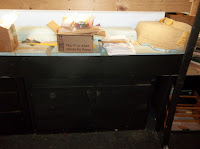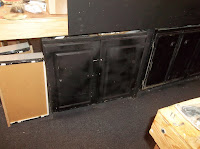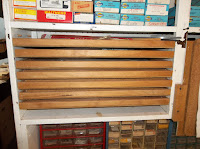In the WWSL blog post Work Spaces I discussed the given and druthers for my modeling space. Here I am going to discuss the project supply specifics.
Given and Druthers
Supplies consolidated based on use. Cleaning supplies separate from project supplies. Supply bins appropriate for the use, size and quantity of the supplies. An overhead shelf to store small scratchbuilding and kitbatching parts and other miscellaneous stuff. Supply bins clearly labeled and easy to move.
If you’re reading this blog, you probably have a collection of long narrow packages of strip styrene, scale lumber, maybe some brass wire and tube and so on setting somewhere awaiting another project. If you do any serious building, you keep a stockpile of all the various dimensions. Organizing and storing them can be a problem.
For those with a luxurious amount of space, the answer seems to be mailing tubes or PVC pipe stacked in a cupboard, and the strips arranged in the tubes. Certainly the local hobby shop has displays organized that way. I tried that one time but it never seemed to work right for me. Small pieces seemed to disappear forever.

I've started to reorganize. I recognize that I have four types of supplies.
1) Cleaning supplies. This runs the gamult from Isopropyl Alcohol to various paint stripping compounds, and other cleaning chemicals.
2) Scenery supplies. This is a wide variety of material including paint, sculptamold, deciduous earth, hydrocal, rubber molds, scale rock and gravel, epoxy for waterways, ground foam, static grass, tree material etc.
3. Locomotive and rolling stock, structure kits, etc. that I still have in boxes.
4. Scratchbuilding and kitbatching stock. Yep ! Stripwood, styrene, brass stock in a variety of shapes and sizes. Not to mention lengths!
Cleaning supplies was easy. A wall cabinet from the restore put above the set tubs holds a variety of cleaning and stripping materials. I am also going to use it for spray paint storage ... I have too much of it in too many locations I can't keep track of what I've got.
Scenery supplies was also easy. Two solutions here. First I recycled an old garage cabinet to hold the heavy scenery supplies. Second, I repurposed a rolling caddy (See 11.1.6 Rolling Caddies for additional details) to hold the more frequently used materials. The caddy drawers hold what was previously taking up 8 linear feet of roadway.
|
|
|
Modeling kits was an interesting endeavor. I needed alot of space for this. Two cabinets and a couple of shelves over the workbench in fact. The majority of modeling kits are stored in two under the layout cabinets. Organized by rolling stock or structure, further organized by car or locomotive type. Each type has their own box, usually a used USPS box that contains each type by project number.
|
|
|
Projects that are in current production or are in 'part purchasing phase' are located on a shelf over the workbench. Also on that shelf is other boxes contain rolling stock parts: trucks, underframes by car type, steel weights, doors, and roof walks.
Scratchbuilding and kitbatching supplies are on the lowest shelf and on the workbench top. The lowest shelf got scratchbuilding supplies, and project baggies. The scratchbuilding supplies are stored on the shallow shelves on the left. I made a series of shallow drawers to hold the stripwood, etc. The
drawer is basically a sheet of masonite cut to dimensions, some
quarter-round molding I had laying around and some thin lath strips cut
down to form 5 'troughs' to store each size of material. Each shelf is one inch high - enough room for alot of supplies.
|
|
|
|
The nice part of this layout is that you can consolidate your stripwood, styrene, brass and wire by size, in its own sub-section of the drawer. Just mark the range of sizes on the outer edge of the drawer and you've got a handy index of parts by location. I arranged the packages by the first dimension on the strip, 1x material on the first shelf, 2x material on the second, etc etc. Brass and wire sizes can be similarly sectioned by thickness, using the same subsections in each drawer. You can't mistake 1x4 stripwood or styrene with .040 brass strip or wire sharing a section, and you increase your storage capacity.
24 inch and longer maerial and all sheet material goes into a separate drawer under the tool storage
space. The drawer is long wide and deep. It will easily take most if not
all common sizes of wood, styrene, molded plastic, brass, aluminum
sheet. Each 'trough' has a height of about 2 inches so you can stack by
width and partial pieces can be easily seen for recycling.Easy to get to when you need larger stuff and its out of the way otherwise.
 |
| Kitbatching Supply Location |
So far the reorganization is going well. I've found alot of stuff in boxes I knew I had but I didnt know where it was. I will certainly be more efficient when it comes to the 'Small Projects to Improve Your Modeling Skills' part. Then again this clean-up reorganization is a series of small projects that add up to bigger things, and the WWSL is better off with this accomplishment.










No comments:
Post a Comment